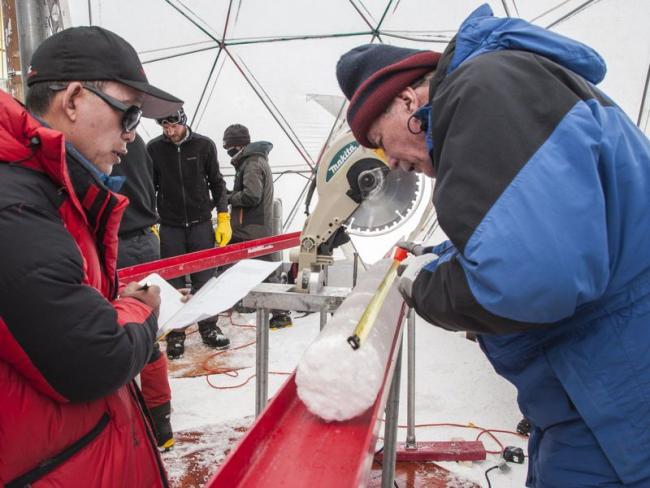Articles Menu

July 26, 2021
Ice core samples from a Tibetan glacier have yielded a collection of viruses and other microbes that are nearly 15,000 years old, reports Isaac Schultz for Gizmodo.
“These glaciers were formed gradually, and along with dust and gases, many, many viruses were also deposited in that ice,” says study author Zhi-Ping Zhong, a microbiologist at Ohio State University, in a statement. “The glaciers in western China are not well-studied, and our goal is to use this information to reflect past environments. And viruses are a part of those environments.”
The glacier in question is known as the Guliya ice cap and researchers collected their ice cores from its 22,000-foot summit in 2015. Prior studies searching for ancient microbial communities in ice have been plagued by contamination for the same reason that the microbes can be found in the ice: they’re everywhere.
The study used a new technique to avoid contamination that involves removing the outer layer of ice from each core and then bathing it in a mixture of rubbing alcohol and water to sterilize the surface, reported Maddie Bender for Vice in early 2020, when a pre-print version of the paper was published on BioRxiv before the peer-review process.
“The biomass is so low that anything you contaminate it with on the outside is going to be at much higher concentrations than anything on the inside of the ice core,” Scott O. Rogers, a molecular biologist at Bowling Green State University who was not involved in the study, tells Vice. “The decontamination issues are extremely important; otherwise, you're going to just get garbage.”
When the team analyzed the 1,017-foot-deep ice cores, researchers found genetic material from 33 different viruses that had been frozen for nearly 15,000 years, 28 of which were new to science, reports Jack Guy for CNN.
In the time of the coronavirus pandemic, the phrase “ancient virus” might justifiably make people uneasy, but the researchers say that people shouldn’t worry about their experiments.
“The way we work with these cores, [the viruses] are immediately ‘killed’ by the chemistry of nucleic acids extraction, so the viruses are not active,” study author Matthew Sullivan, a microbiologist at Ohio State University, tells Gizmodo.
But climate change is melting glaciers and thawing permafrost, which does have the potential to release active viruses that haven’t circulated on Earth in thousands of years. Some researchers, including Rogers, suggest this presents the real and dangerous possibility that one of these defrosted pathogens might infect humans and cause harm.
However, the viruses described in this paper as well as in prior research have been geared towards infecting bacteria and amoebas rather than bigger hosts like humans. Furthermore, the viruses discovered in the Tibetan ice cores would need to be adapted to surviving in extremely cold temperatures, which would severely limit their ability to spread to new locations on the planet.
By studying these millennia-old microbes, Sullivan tells CNN he and his co-authors hope to better understand the pace of viral evolution and to better understand the microbial communities of the past.
“We know very little about viruses and microbes in these extreme environments, and what is actually there,” says Lonnie Thompson, senior author of the study and earth scientist at Ohio State University, in the statement. “The documentation and understanding of that is extremely important: How do bacteria and viruses respond to climate change? What happens when we go from an ice age to a warm period like we’re in now?”
Alex Fox is a freelance science journalist based in Washington, D.C. He has written for Science, Nature, Science News, the San Jose Mercury News, and Mongabay. You can find him at Alexfoxscience.com.
[Top photo: Researchers extracting an ice core from the Guliya Ice Cap in the Tibetan Plateau in 2015. (Lonnie Thompson / Ohio State University)]